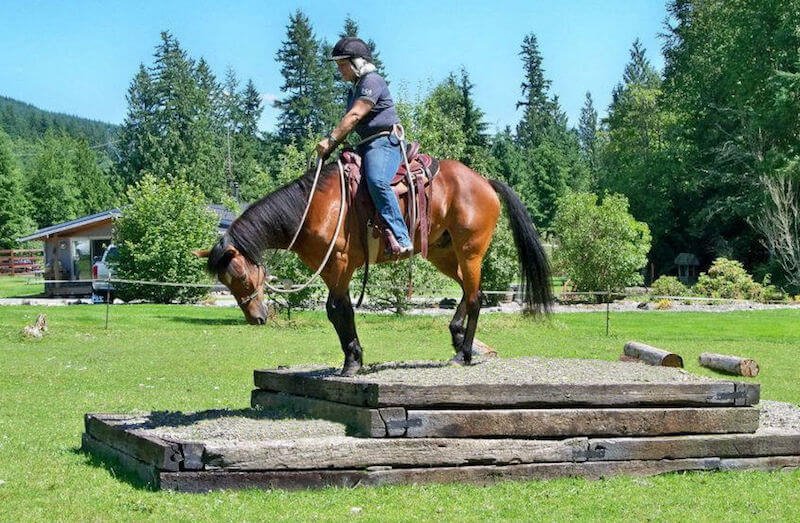Understanding a Horse’s “Mind’s Eye”
by Marilyn Pineda, Fire Mountain Trail Course
It’s just a puddle, dummy!” Most horses in the Pacific Northwest have heard this at one time or another. Meanwhile, the horse is thinking, “Is that watery hole going to swallow me up?” Understanding how horses see – which directly affects how they think – is a crucial tool if we desire effective communication with them, both from the ground and in the saddle.
As prey animals a horse’s eyes are set on the side of their head to give them greater peripheral vision, usually about 350 degrees. They have a blind spot directly in front of their face between their eyes, as well as the narrow area carried straight out directly behind their rump. Most of their vision is monocular, meaning each eye “sees” separately from the other. What horses see out of the left eye goes into the left side of their brain, and what is seen by the right eye goes into the right side of their brain. The two sides of the equine brain have very little connection with each other so the data received from each eye is not processed collectively together. Not only does each side of the brain see separately, but odds are that each side reacts differently to given situations. In other words, one side of their brain is likely to be “calmer” than the other side. This is why a new object by the gate post might be more frightening coming in to the barnyard than it was when you were going out – your horse is seeing it for the first time, again, from a possibly more reactive brain.
Allowing your horse the opportunity to explore strange obstacles from every available direction lets both sides of his brain become acquainted with the challenges it may present. And because it is necessary to be prepared for a variety of responses, I always encourage visitors at Fire Mountain Trail Course to introduce their horse to new obstacles in hand before mounting up. Exploration from the ground offers greater safety as it strengthens communication skills and builds newer levels of trust between the horse and his human.

Another consideration is depth perception in the horse – or the lack thereof. Two eyes working together for binocular vision are needed to obtain depth perception. Horses can focus binocular vision on things at a distance by raising their head, but their binocular vision is brought down to the ground in front of their feet when their head is brought into a vertical position. Your horse cannot look forward at any distance if his head is being held down, much less judge depth or distance when coming to an obstacle of some sort.
I’m sure you can see how these visual limitations contribute toward fidgety feet, hesitations or refusals when approaching strange bridges or ominous puddles. We need to allow our horse to position his head so he can obtain effective vision for the challenges that are presented to him, and give him time to process it.
And what about when you are out enjoying a wooded trail and your horse reacts to movement or something he hears coming his way from behind? I mentioned his 350 degree peripheral vision earlier, but when you are riding him your legs are blocking that vision by several degrees on each side. The farther back those angles are carried from each eye towards his rear, the wider the blind spot becomes behind his rump. If he is spooky and has not been able to develop complete confidence in you as his leader-protector he is going to want to enter into flight mode, away from what startled him, and then swing around to face it to assess the danger. Keeping this in mind as you ride can help work with unexpected situations. Making an effort to see things from your horse’s perspective, and meeting him in his world as you communicate, creates a better and safer ride for both of you.
Published June 2013 Issue

The Colorado Horse Source is an independently owned and operated print and online magazine for horse owners and enthusiasts of all breeds and disciplines in Colorado and surrounding area. Our contemporary editorial columns are predominantly written by experts in the region, covering the care, training, keeping and enjoyment of horses, with an eye to the specific concerns in our region.

